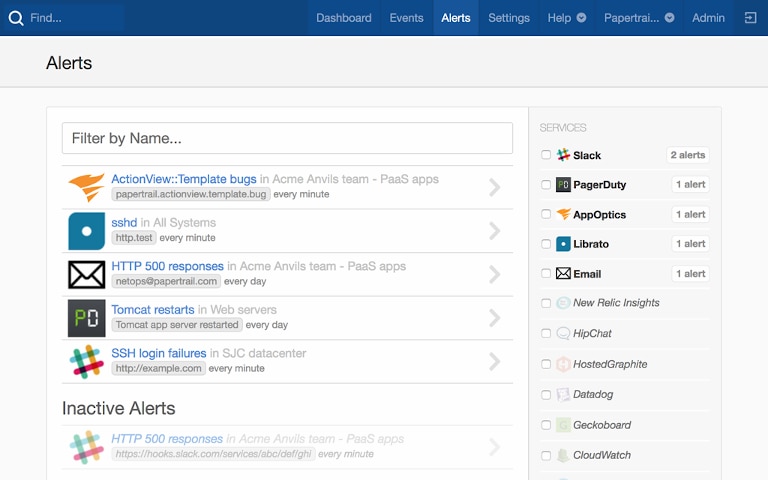Logs are the computer-generated records created by network devices, operating systems, applications, and programmable/smart devices. These logs help organizations monitor, analyze, and manage IT systems. They provide insights into the organization’s network so teams can proactively identify issues impacting business performance, compliance, and security. While these logs are generated in massive amounts, teams need to organize them in a centralized location with the help of reliable tools like SolarWinds® Papertrail™. However, centralizing logs isn’t enough. To extract useful information from logs, system administrators need to follow up with log analysis.
What Is Log Analysis?
Log analysis is a process of analyzing computer-generated logs. It can be used for various purposes, such as:
Resolution of Data Breaches and Security Threats
Logs provide a wide range of information such as client/server requests, IP addresses, and HTTP status codes capable of preventing data breaches. With log analysis, teams can track down suspicious activities and set up parameters, thresholds, and rules to secure the business’s network infrastructure. Log analysis tools also help in the detection of anomalies by setting alerts. These tools use advanced technologies like machine learning and artificial intelligence to spot patterns and behaviors, so potential threats can be eliminated.
System Troubleshooting
The major role of log analysis is to troubleshoot server, network, system, and application errors from crashing due to issues like configuration and hardware failure. Log analysis not only helps teams to identify network downtime and performance issues quickly but also enables admins to solve critical system errors and improve operational efficiency.
Regulatory Compliance and Audits
Organizations need to follow government-set standards to adhere to guarantee safety and functionality, and to meet compliance requirements. Log file analysis also helps with litigation needs, forensic investigations, audit requirements, and subpoena requests.
Online User Behavior Analysis
Log Analysis provides useful metrics to help mitigate risks/events, comply with security policies and audits, and help teams understand online user behavior with behavioral logs. With a handful of data, trends, and patterns on user behavior, organizations spot various opportunities like when to send a newsletter, pause a website to start the maintenance, launch a product or service, and more.
What Are Behavioral Logs?
Behavioral logs are the records of how and when users interact with computer systems and online services. These logs include user actions/activities such as:
- The number of times the website is visited, and the content is viewed
- Time spent on a particular web page of a site
- The number of keystrokes while interacting with a productivity app
- The search queries captured by web search engines
- Browsing history and patterns
Behavioral logs don’t capture the existing impressions of user behavior. Instead, it provides accurate data to help organizations understand the real-time user behavior. These behavioral logs can be collected using a client machine and remote servers.
Understanding User Behavior With Log Analysis
To understand user behavior, system administrators need to analyze log data and extract various metrics. Metrics can be descriptive and undescriptive. Undescriptive metrics emerge directly from the data. For instance, the trend and pattern of a query based on a particular timeline (month, week) can be directly determined using information such as the type of query, query length, and the frequency of query search. However, the descriptive metrics consist of the raw data in a summarized form needing to be aggregated, transformed in a unified format, and compared with existing metrics to get meaningful insight into actual user behavior.
How Does Behavioral Log Analysis Help Businesses?
To ensure various business operations are on track, organizations need to focus on capturing quality data and performing quality analysis on the same. Behavioral log analysis is perfect for this task. It not only offers various opportunities but also helps businesses identify potential threats and weak points in the network environment. This aids system administrators to resolve potential issues, and improve the overall efficiency and security of the business. With behavioral log analysis, teams learn more about their customers/website visitors, understand how these customers will act in future interactions, and make informed business decisions.
Role of Log Management Tools in Behavioral Log Analysis

Log management tools like SolarWinds Papertrail fasten the troubleshooting process through log analysis. It’s a cloud-hosted log management tool designed to aggregate logs from various sources such as social media, applications, systems, and more. It automatically scans all the consolidated logs, parses them into a single unified format, and stores all the log files at a centralized location for resolving errors. Papertrail facilitates teams with real-time tail and searches log features to help search large volumes of log messages in a flash. With its elegant alerting feature, teams can set alerts and get notified about threats and issues via email, SMS, or push notifications about events, threats, and real-time user activities. Papertrail log management tool is also capable of analyzing logs for quick identification of patterns and anomalies. Administrators can filter logs based on the priority of the business and secure them with TLS encryption and certificate-based destination host verification. Papertrail is one of the best log management tools accessible via a web browser, command-line client, and HTTP API.
Conclusion
Log analysis is a critical process under log management. It not only helps in monitoring, alerting, and detecting events, but also helps to resolve issues, improve productivity, and meet government compliance. By using tools like Papertrail for log management, organizations can readily identify potential threats, performance issues, and initiate a rapid response to mitigate risks.
